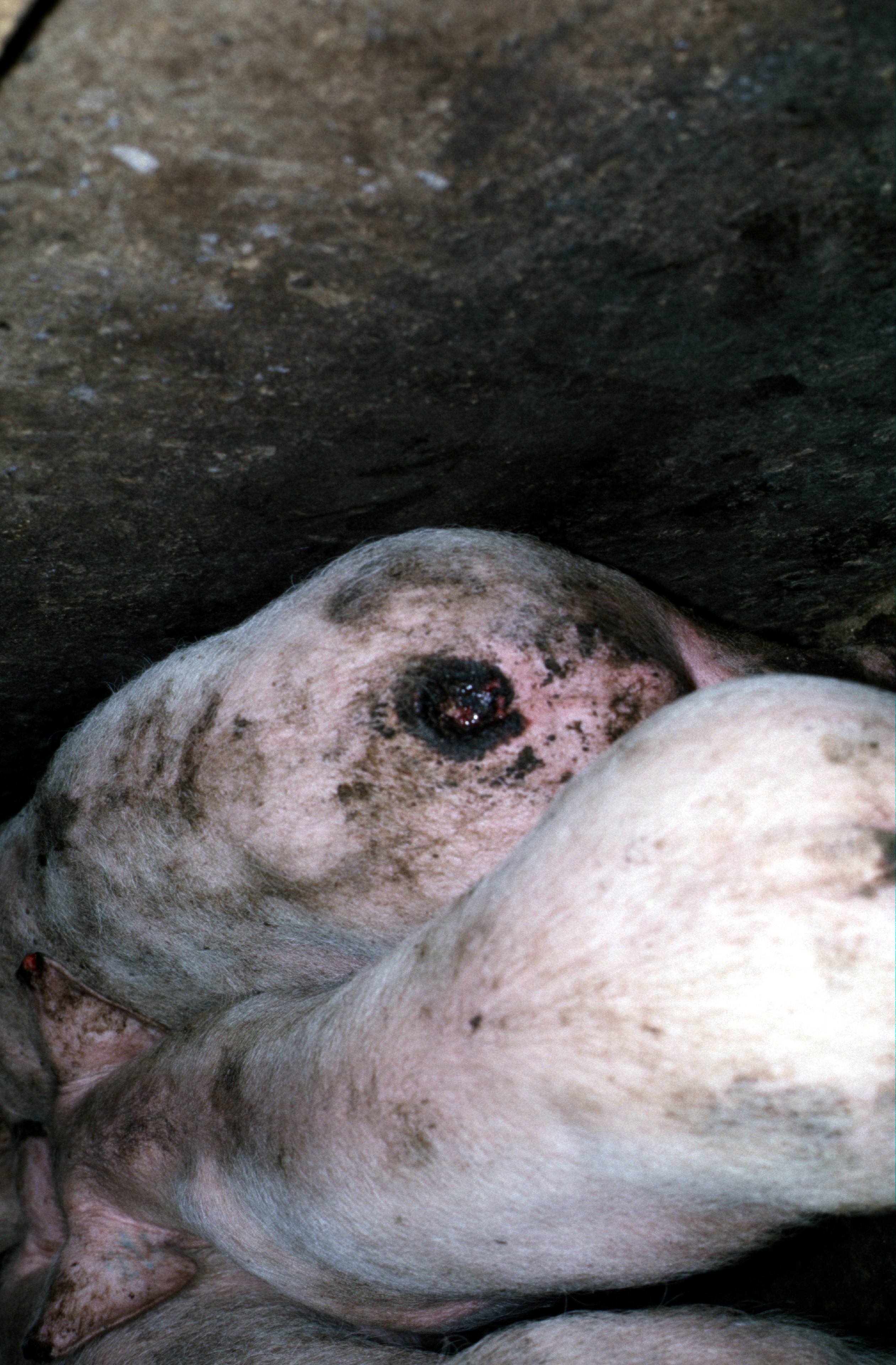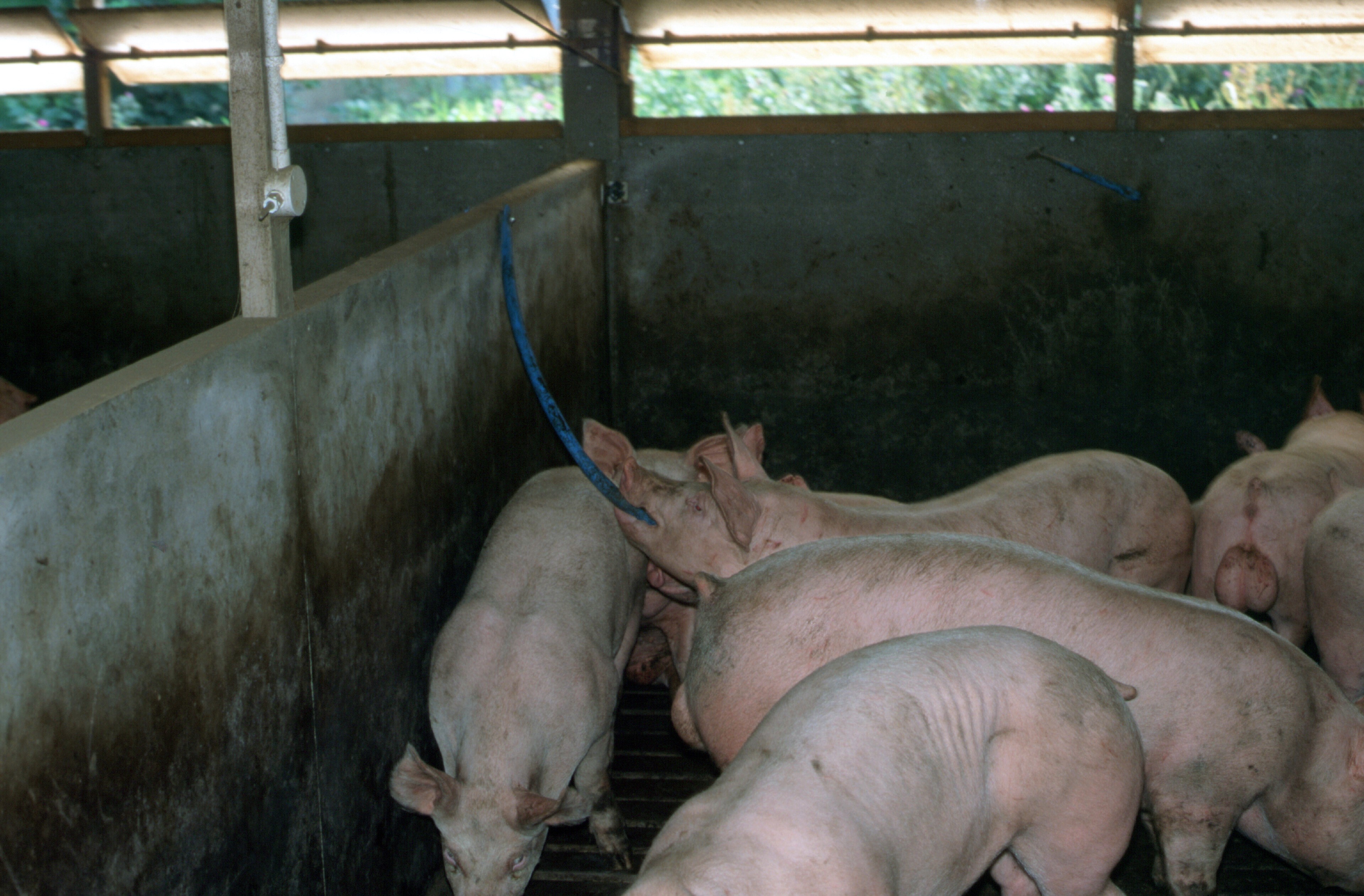Aberrant aggressive behaviour in pigs is widely referred to as vice.
In the growing pig this can take the form of tail, ear, flank, stifle or even vulva or penis biting - all various forms of cannibalism. However, tail biting is viewed as the most widespread and serious of these problems Clinical surveillance undertaken by veterinary surgeons has suggested that the overall prevalence of tail biting across many herds is 1.2% and that the prevalence in different systems highlights the widespread nature of the problem. No one system of pig keeping is immune from tail biting. Slatted systems have seen a prevalence of 2% of pigs affected whilst on straw the figure is only 0.4%. Indoor derived growing pigs are 50% more likely to be tail bitten than those born outdoors. (NADIS data)

Damage to pigs' tails by pen mates contributes a major loss to the pig industry. Tail biting tends to be seen in a number of different scenarios ranging from a constant low grade problem in a continual production unit to explosive outbreaks in batches. As such, the incidence is highly variable. In the former scenario, 3-5% of pigs may be affected week in week out and it would be common place for 1% to require euthanasia and a similar proportion to be condemned at slaughter (usually referred to as "pyaemia" on a condemnation sheet). At this level, the cost to a 300 sow breeder feeder farm can be £14000 per year (140 pigs per year lost) plus the costs of treatment, care, isolation and lost growth.

Fig 1 Severely tail bitten pig requiring euthanasia
In a batch systems, losses as high as 30% of pigs have been experienced - out of a batch of 700 pigs, 208 either died, were destroyed or were condemned at slaughter!

Fig 2 Undocked pigs in deep straw systems are not immune from tail biting
BPHS data derived from regular slaughterhouse monitoring at the main pig abattoirs in England indicates that the recorded incidence of tail bitten pigs presented for slaughter is much lower than the clinical surveillance suggests. This is due to the combined effects of severe cases being destroyed humanely on farm as they are unfit for presentation for slaughter for human consumption and the fact that they are not welcomed at mainstream plants with high speed lines and are thus diverted to smaller specialist abattoirs where BPHS does not operate.
Causes
Pigs have a natural tendency to chew. They are also attracted to blood and once biting has started it tends to be contagious. In addition, pigs undergo teeth changes between 3-4 weeks of age and 7-8 months. Anyone who has reared children will recognise the desire to chew during teething and this may be a component of piglet behaviour. Normal inquisitive investigation with the mouth can lead to "accidental" bleeding, which can lead to more serious damage. However, there is no direct link between mild tail lesions resulting from exploratory behaviour per se (as measured during Real Welfare Outcomes assessments) and full blown aggressive biting.
In any given situation where tail biting occurs, there is a need to undertake a full investigation and assessment to identify the possible trigger factors. In many cases, a single rogue animal can be identified that has started the problem in a group - usually the smallest pig - although if not spotted early this animal may get lost in the group that join in.
A huge range of environmental, dietary and husbandry factors have been identified as acting as triggers for tail biting, ranging from stocking rates (overstocking and understocking), temperature variation, draughts, competition for food and water, to Vitamin E deficiency and high fat diets. Professional veterinary advice is essential to unravel the significant factors and identify the cause of "unhappy pigs". The inability of some pigs to find a comfortable draught free lying area is one of the major triggers for tail biting recognised on farm.
Unfortunately, the "perfect" system has not been identified and, even if it could be, there are always likely to be cost constraints that will compromise its adoption! It, therefore, unfortunately must be accepted that tail biting is a consequence of farming pigs and producers should attend to the basic biological needs of the pig to minimise the risk of damage.
Such areas for consideration include:-
1) Thermal comfort:- draughts, temperature variation, chilling and over-heating are highly significant factors.
2) Freely available feed and water - the pig that is unable to get to a free supply of feed and water is always more likely to seek revenge on its penmates.
3) Feed diets that are appropriate to the pig and contain a full balance of nutrients.
4) Stocking density. Space provision should be determined by the nature of the accommodation and the requirements of the specific pigs. The Welfare of Farmed Animals (England) Regulations (2007) (the successor to The Welfare of Livestock Regulations 2000 & 1994 and Welfare of Farmed Animals 2003 Regulations) have done a great disservice to the pig. These regulations state the minimum space requirements for pigs of different weight. Putting aside the nonsense of a stepped graph (pigs of 19 and 20kg require the same space but those of 21kg require 50% more!) these minimum requirements have been interpreted as the optimum requirements. (A similar view is taken throughout Europe). Producers must be aware that these figures were not based on any sustainable science and, as such, are totally meaningless to the true needs of the pig. Perversely however, if stocking rates are too low thermal comfort may be difficult to achieve and trigger tail biting. It is widely believed that provision of straw as bedding provides pigs with environmental enrichment sufficient to fulfil behavioural needs and prevent vice. In itself this is simply not true - biting is seen sometimes in explosive outbreaks on deep straw systems. However, a deeply bedded floor will enable thermal comfort to be achieved more easily than say fully slatted pens where the pigs are totally dependent on fan and inlet settings. As such low grade constant tail biting problems may be less significant on straw but massive outbreaks can occur.
Concomitant disease is a major trigger of outbreaks of tail biting. The complex pathological and physiological factors brought into play by major systemic disease such as pneumonia, scour and wasting cause malcontent and aggression to develop, and tail biting is a common consequence.
Treatment
Bitten pigs must be isolated to prevent further damage. The bitten tail can be dressed/sprayed with antiseptic or proprietary "antibiting" sprays can be applied. Stockholm Tar painted over a damaged tail will minimise further damage in hospital areas. The veterinary surgeon may prescribe treatment with broad spectrum antibiotics to prevent spread of infection within the body from the open wound but care is needed to observe meat withholding periods. A failure to treat can lead to introduction of bacteria through the tail wound which tracks up the main lymph trunk under the spine and sets up abscesses in or close to the spinal canal. These may be found as incidental findings at slaughter (rendering the carcass unfit for human consumption) or cause paralysis in the live pig necessitating euthanasia on farm. Similarly, infection can become bacteraemic and spread to joints producing intractable septic arthritis. As a rule of thumb any pig that is known to have been tail bitten and is lame due to joint swelling requires on farm euthanasia.

Fig 3 Advanced septic arthritis secondary to tail biting. Euthanasia is overdue.
Prevention
Quite apart from attempting to fulfil behavioural needs of the pigs, a number of features can be applied to reduce the incidence and impact of tail biting.
1. Providing toys in the form of chewable material. There is a statutory requirement under the Welfare of Farmed Animals (England) Regulations 2007 to provide environmental enrichment and applies particularly to fully slatted pens. Such equipment as chains, alcathene piping (care of blocked slurry pumps), rubber boots, wood etc are valuable but must be in place at all times - it is too late introducing them once a problem has started, in particular in relation to their health.

Fig 4 Suspended alcathene piping is enthusiastically chewed by growing pigs
The Regulations require provision of organic material (eg straw, sawdust, peat etc) but in fully slatted systems these are unmanageable. Old car tyres should not be used as the steel wire core becomes exposed and can penetrate and damage pigs' mouths. There is no prescribed minimum amount of environmental enrichment material to be provided nor is there any specification that multiple forms should be supplied or indeed that they should be regularly rotated. In some farms it has been found that regularly changing materials makes the pigs more active and aggressive and actually makes biting problems worse.
2. Tail docking. Despite the fact that UK legislation bans the routine tail docking of pigs, this remains the only reliable method of preventing tail biting in situations where it is experienced or it can reasonably be anticipated. Any attempts to totally ban the procedure would lead to major welfare problems. The technique must be done within the first 7 days of life (first 3 days under RT quality assurance rules) and be done cleanly and efficiently by a competent trained individual preferably using thermocautery. It adds to workload within the farrowing area. Training can be provided by the veterinary surgeon. The length of tail removed will depend on individual circumstances, identified by the veterinary surgeon and, in high risk cases, very short docking is both acceptable and essential, but should be reviewed constantly. Records of tail biting should be kept on farm.
3. Dietary supplements. Increasing salt levels in diets has long been used as a way of preventing tail biting and can be effective. However, care must be taken to avoid excessive intake and salt poisoning. Talk to both your nutritional advisor and your veterinary surgeon before increasing salt levels in diets.
4. Review stocking rates, health control protocols and overall health management of the herd to minimise the trigger factors for tail biting.
5. Undertake a review of ventilation systems including smoke tests and temperature gradient measurements and correct any faults.
Slaughter
Tail bitten pigs present a major challenge to the slaughterer with secondary infection spreading via the blood stream/lymphatic system to any part of the body. The result of this infection is total condemnation.
The guidance issued by Pig Veterinary Society on the appropriateness of slaughter of tail bitten pigs is that:
- If no tail is left, an open wound exists or there is evidence of swelling/abcessation around the base of the tail the pig should not be presented for slaughter for human consumption. It should be destroyed humanely on the farm.
- If a previously bitten tail has healed leaving no open wound or swelling it can be sent for slaughter accompanied by a food chain information declaration.

